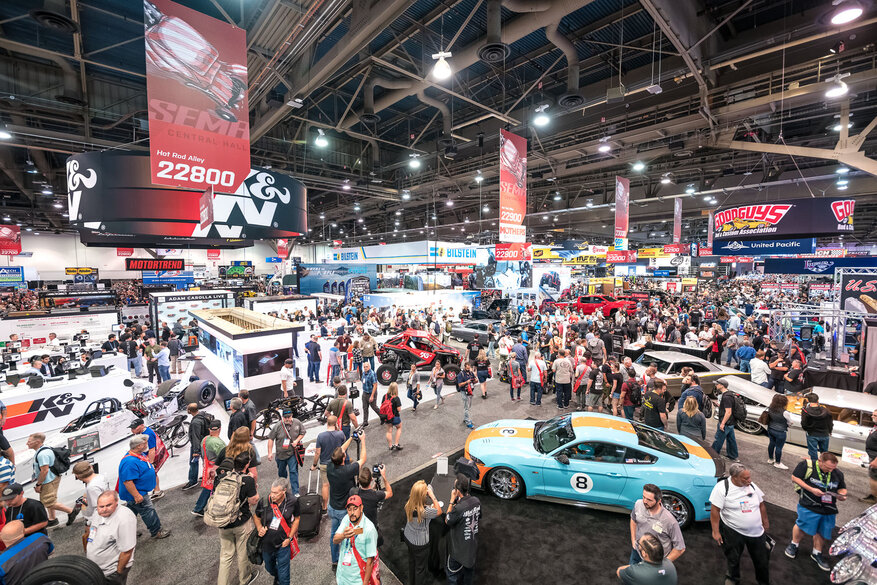by Matt Konkle
Managing Editor
LAS VEGAS — They show up from everywhere around the world to this constantly brilliant oasis in an otherwise desolate part of Nevada.
Some arrive to show off their latest wares, some to gather knowledge. And some to discover exactly what product will turn potential customers into life-long friends.
The Specialty Equipment Market Association (SEMA) show.
A five-day jolt of automotive adrenaline each November that touches almost every facet of the industry.
Awards are presented, cars and trucks honored as leaders in certain categories, educational seminars spread the word on multiple trends, tire smoke hangs over multiple parking lots following riding demonstrations, and more than 2,000 exhibitors hang out a shingle to attract a projected audience of more than 130,000 people.
All of this pushes the SEMA event on stage as one of Las Vegas’ top yearly attractions.
But for all those who attend, as well as for exhibiting manufacturers and vendors, there is still the notion SEMA is just a show even though its roots stretch way deeper into the industry.
SEMA was first started back in 1963 by people who loved cars and trucks, and wanted to turn that passion into a career. The original goal, according to the organization, was to develop uniform standards for certain products used in motorsports competition; promote the industry as a supplier to consumers involved in constructive activities of recreational and hobbyist value; develop programs to encourage improved business practices among member companies; and hold regular meetings to achieve unity as a business organization. In those days, members were founders of companies that exclusively produced speed equipment.
Over the years, the fold grew into a nearly 6,500-member-based powerhouse contributing to the vitality and strength of the automotive aftermarket’s $30-billion-a-year industry.
Its members come from all walks of automotive life now, including businesses in the distribution chain, manufacturers, warehouse distributors, jobbers, independent retailers, volume retailers, specialty stores (speed shops), sales agents, subcontractors and publishing companies. Memberships even include racing teams, car clubs and special service organizations. Products supplied by the industry are found not only in the United States but also throughout the world.
These days, SEMA performs many educational and data services for its members and the industry as a whole. More importantly, heading into 2025, SEMA is working hard to protect consumers’ rights to drive accessorized, customized, and vintage vehicles and keeps close tabs on legislators nationwide.
For example, SEMA pressure helped Pennsylvania legislators recently pass a law legalizing doors-off driving in Jeep vehicles like Wrangler and CJ. Additionally, the organization filed a lawsuit against the state of California's attempt to ban internal combustion engines. SEMA is also very involved in efforts across the country regarding recreational access to public lands. All so its members and anyone who loves cars and trucks can protest pending legislation that might harm those hobbies, or endorse legislation that is good for the industry.
SEMA has also helped numerous consumers interact with car dealers, who sometimes try to get away with charging for repairs on a modified vehicle by wrongly claiming that specialty accessories have voided the warranty.
”The SEMA show is five days; the other 360 days of the year we use the resources from our members to create a collective voice,” said former SEMA President Chris Kersting during a Quadratec interview in 2018. “We do a lot of different things, but one thing we do is take care of legislative and regulatory issues that kind of encroach on the hobby. With the off-road scene there is constant pressure.
”One thing that would be good (for Jeep enthusiasts) would be to go to the SEMA website and look for the SEMA Action Network. It is a grassroots way for you to be informed on what is going on out there, when we have problems, when we have threats, and to protect the opportunity to get out there on the trails.“
Another way SEMA strives to help its member companies, which in turn helps consumers, is that it performs quite a bit of market research to assemble viable data and trends through its Research and Information Center. All members have access to this information, which can be used to formulate sales and trend projections for the coming years.
The show, however, certainly remains the shining jewel of the SEMA year. And for those in the Jeep aftermarket, it can be the perfect time to discover new products, make new contacts and even show off your skill as a Jeep vehicle builder. Also, those new products revealed and displayed during the show tend to set the Jeep aftermarket product tone for the coming year and beyond.
"The bottom line at SEMA, as it shall always be, is a combination of quality and service,” Kersting said on the company’s website. “The ingredients for a successful trade association are performing to the satisfaction of its member companies and accommodating industry growth and diversification. SEMA attempts to set the pace for others to follow. That's why our membership roles continue to increase in number."
Related Articles:
Five Things You Can Do Today In Your Jeep Wrangler





















